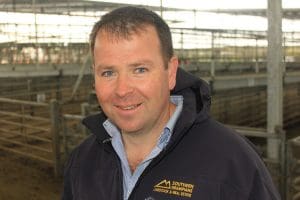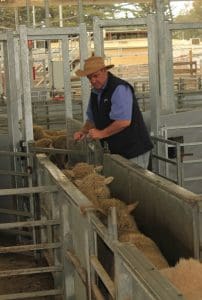
Hamilton and District Stock Agents Association president Heath Templeton.
HAMILTON and Ballarat livestock agents believe a State Government decision to move to a 90 percent electronic tag read requirement for sheep and goats in saleyards and abattoirs from late March next year is premature.
The Hamilton saleyard’s manager believes the new EID tag read rate requirement can be achieved, but the agents would have have preferred to see how the new EID system worked during the spring lamb turn-off or flush.
Hamilton’s saleyard management and agents helped develop what is now called the Hamilton Draft system which reads the electronic identification (EID) ear tags in sheep they are drafted into sale lots.
The system has been installed in the major Victorian sheep saleyards, but some stock agents have been reserved about its effectiveness until it was tested during the spring prime lamb turn-off or flush.
Hamilton and Ballarat agents said they had not been consulted before the State Government’s decided to raise the EID tag read requirement from 80 to 90pc for Victorian sheep and goat saleyards and processing facilities from 31 March next year.
Hamilton and District Stock Agents Association president Heath Templeton said the Hamilton Draft system had worked well with yardings of up to 15,000 sheep, of which half were lambs, but he was not confident it would achieve the required tag read rates during larger yardings.
“I’m not really going to be sure until we’ve done a full season and I’m happy to say that the government has no idea either.
“We’re the ones who created the Hamilton Drafts and they came to us and asked ‘how is it going to work?’”
Mr Templeton conceded that the Hamilton Draft system was currently achieving read rates of better than 90pc, although on small numbers, and there had been no “disasters”.
But he said it was “moronic” to lift the EID tag read requirement to 90pc when Victoria was the only state in which electronic tagging of sheep and goats was mandatory and when it had not been completely proven that high read rates could be achieved consistently with large numbers of lambs or sheep.
“I think it (the 90pc decision) is premature, maybe they should do 12 months at 80pc before they alter anything.”
Mr Templeton put the lack of consultation on the 90pc decision down to the government wanting to be “trailblazers.”
“Yes, EID tagging of lambs is working in Victoria, but we haven’t seen the flush either here and Ballarat haven’t got going yet, and that’s where 50pc of the lambs will come through.”

Kerr & Co agent Craig Pertzel drafts sheep through the Hamilton Draft system
Kerr & Co Livestock auctioneer Craig Pertzel said the Hamilton Draft was slower than the previous non-EID drafting system. He believed the government should have waited until the EID system was tested with the spring lamb flush, when up to 60,000 lambs would be yarded and scanned in a day.
Ballarat and District Stock Agents Association president Xavier Bourke believed the decision to move to a 90pc read rate should only be made after reviewing EID systems in saleyards after the spring lamb flush. He also queried the level of consultation the government undertook before making the decision to lift the tag reading performance level.
“We would have liked to have been consulted on this and secondly, there should be a review period.”
Hamilton saleyards manager says 90pc read is not a problem
Hamilton Regional Livestock Exchange manager Chris Dahlenburg was also unaware of the decision to go to the 90pc EID read requirement next year, but the saleyard was achieving read rates of 80 to 100pc, with the lower rates being due to sheep or lambs without tags. He believed the Hamilton Draft system could meet the 90pc read requirement by March next year.
“I don’t think there is going to be a problem, it’s just bigger numbers.”
He didn’t think deferring the 90pc read decision until after the spring lamb flush would make “any difference whatsoever at all.”
Southern regional manager for EID systems provider Outcross, Peter Brooker, said read rates could also improve with the larger single vendor lamb lines during the spring turn-off.
“As long as they’ve got tags, we will be right.”
Victoria’s Minister for Agriculture Jaala Pulford yesterday said the EID tag read action and performance levels were being lifted because most saleyards and abattoirs are already reading close to 100 percent of the electronic NLIS tags on sheep and goats. The impact of raising the read rate levels is expected to be minimal, she said.
Chair of the Sheep and Goats Identification Advisory Committee Stuart McLean yesterday said increasing action levels for saleyards and processors on the 31st March 2019 will be very attainable by the industry, particularly with six months to prepare and plan for these changes. Mr McLean and Ms Pulford could not be contacted for further comment.

HAVE YOUR SAY